
Peeblesshire, the County of Peebles or Tweeddale is a historic county of Scotland. Its county town is Peebles, and it borders Midlothian to the north, Selkirkshire to the east, Dumfriesshire to the south, and Lanarkshire to the west.

Sir James Montgomery, 1st Baronet Stanhope, FRSE was a Scottish advocate, judge, country landowner, agriculturalist and politician who sat in the House of Commons from 1766 to 1775. In 1783 he was a joint founder of the Royal Society of Edinburgh.
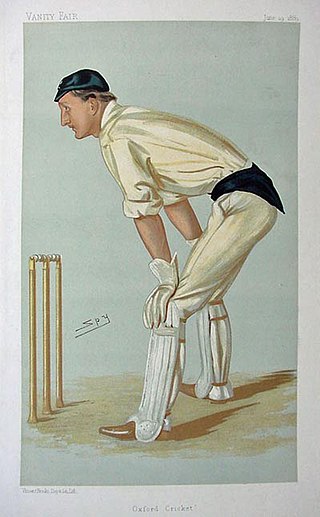
Hylton "Punch" Philipson was a cricketer who played first-class cricket for Oxford University between 1887 and 1889 and for Middlesex between 1895 and 1898. He played five Test matches for England between 1892 and 1895.

Broughton is a village in Tweeddale in the historical county of Peeblesshire in the Scottish Borders council area, in the south of Scotland, in the civil parish of Broughton, Glenholm and Kilbucho and Upper Tweed Community Council. Broughton is on the Biggar Water, near where it flows into the River Tweed. It is about 7 km east of Biggar, and 15 km west of Peebles.
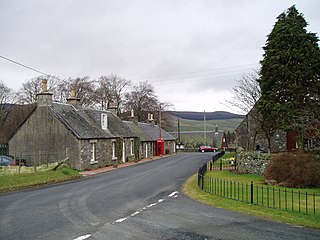
Drumelzier, is a village and civil parish on the B712 in the Tweed Valley in the Scottish Borders.

Tweedie or Tweedy is a Scottish clan name. The Clan Tweedie does not currently have a chief recognized by the Lord Lyon King of Arms and is therefore considered an Armigerous clan. However the surname is also considered a sept of the Clan Fraser. The name is derived from the lands of Tweedie which were along the Valley of the River Tweed in Peebleshire in the Scottish Borders.
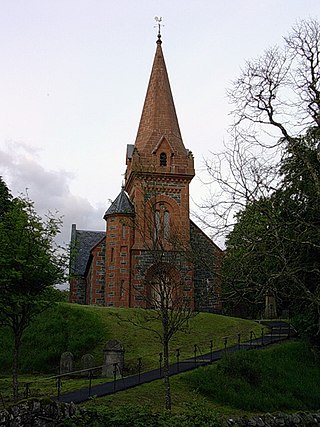
Tweedsmuir is a village and civil parish in Tweeddale, the Scottish Borders Council district, southeastern Scotland.

Sir John Murray of Broughton, 7th Baronet of Stanhope, also known as Murray of Broughton, was a Scottish baronet, who served as Jacobite Secretary of State during the 1745 Rising.
Polmood is a small settlement in southern Scotland near Tweedsmuir in the Scottish Borders, in the valley of the River Tweed.
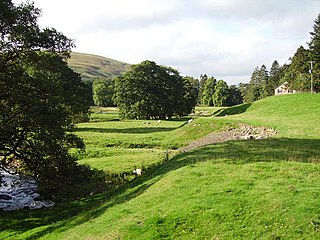
Kingledoors is a group of settlements in a valley in southern Scotland near Tweedsmuir in the Scottish Borders, in the valley of the River Tweed. It is part of the parish of Drumelzier and is bounded on the north by Mossfennan, on the east by Polmood, on the south by the lands of Crook and Oliver.

Stobo Kirk is an ancient church of the Church of Scotland. It is dedicated to St Mungo and is situated near the B712 off the A72 just 6 miles south-west of Peebles in the ancient county of Peeblesshire, now part of the Scottish Borders Council area.

Dawyck Chapel, also known as Dalwick Church, is located within the Parish of Drumelzier in the Scottish Borders area of Scotland. The chapel lies within the Dawyck Botanic Gardens, an outstation or "regional garden" of the Royal Botanic Garden Edinburgh, some eight miles (13 km) south west of Peebles on the B712 and a similar distance south east of Biggar.

Broughton Place is a historic house in the village of Broughton, Scottish Borders. It was designed by Basil Spence in the style of a 17th-century Scottish Baronial tower house.

Dawyck House is a historic house at Dawyck, in the parish of Drumelzier in the former Peeblesshire, in the Scottish Borders area of Scotland. The alternative name is 'Dalwick House'. Canmore ID 49816.
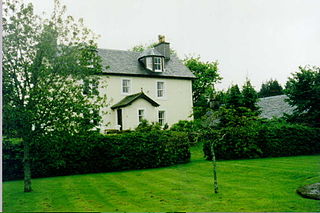
Menzion, sometimes Minzion is a small settlement in southern Scotland near Tweedsmuir in the Scottish Borders, in the valley of the River Tweed.

Stobo Castle is located at Stobo in the Scottish Borders, in the former county of Peeblesshire. The Manor of Stobo was originally owned by the Balfour family. It became the family seat of the Graham-Montgomery Baronets from 1767. The building of the present castle began in 1805 and was completed in 1811 under the supervision of architects Archibald and James Elliot. It is currently operated as a health spa. The house is protected as a category A listed building, while the grounds are included in the Inventory of Gardens and Designed Landscapes in Scotland, the national listing of significant parks and gardens.

The John Buchan Way is a walking route from Peebles to Broughton in the Scottish Borders, a distance of approximately 22 km. The route is waymarked in both directions, and was opened in spring 2003. It is named after the writer and diplomat John Buchan (1875–1940), who has many associations with the area. The route mainly follows long-established hill tracks through the Peeblesshire countryside. It has three main ascents and descents which give a total climb of about 800 metres, but this climb is never severe. The walk can be completed in one day by strong walkers, or can conveniently be split.

The Barony of Stobo is a Scottish feudal barony which takes its name from Stobo in the Scottish Borders.
Sir David Murray, 4th Baronet was a Scottish Jacobite soldier.
This page is based on this
Wikipedia article Text is available under the
CC BY-SA 4.0 license; additional terms may apply.
Images, videos and audio are available under their respective licenses.















